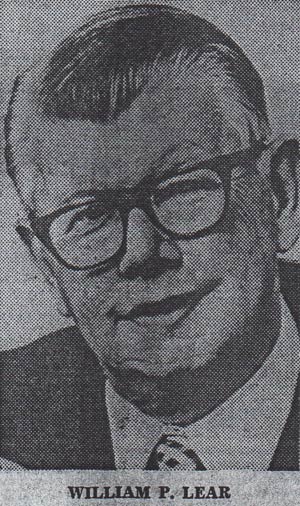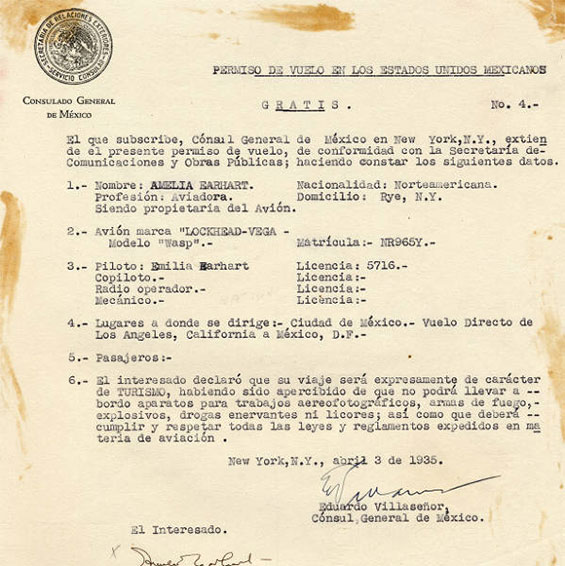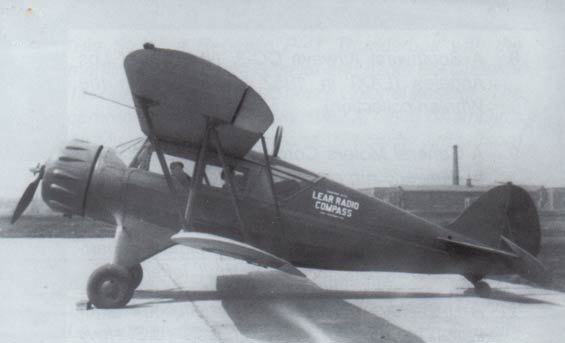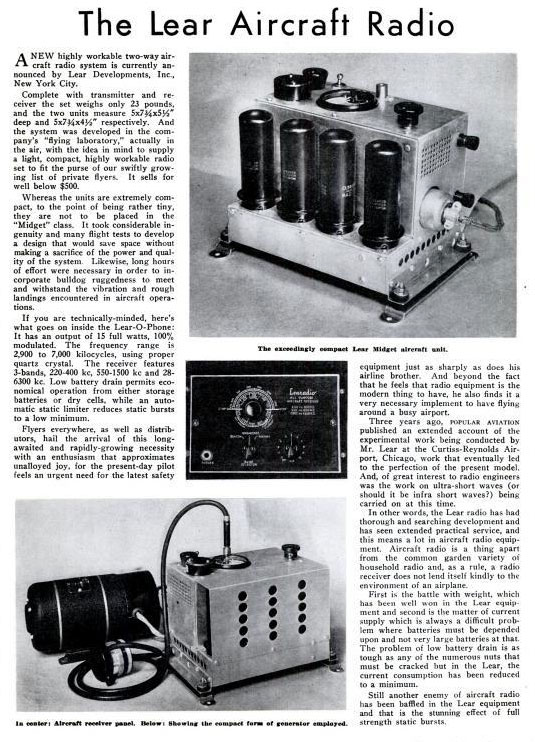Bill Lear, From His 1978 Obituary (Source: The Washington Post)
 |
Bill Lear was born in Hannibal, MO on June 26, 1902. He died of leukemia at age 75 May 14, 1978 in Reno, NV. He was one of the most illuminating and tenacious inventors and entrepreneurs of the 20th century. A document in his NASM biographical file (cited, left sidebar) described him as an, "Inventor, designer, test pilot, business man, music lover, and realist."
Indeed, Lear held over 150 patents for things mechanical and electronic that have affected the lives of most human beings. Among them, he invented the automobile radio. Who among you hasn't listened to a car radio? Or, for those who remember such things, the 8-track tape player, which Lear also invented for automobiles.
He invented the autopilot and other guidance instruments for airplanes. True, the technology behind these devices has changed over the years, but the fundamental operating principle survives in most automobiles and aircraft today, and we have Lear to thank for that.
As well, he and his company designed, developed and manufactured a line of small, sleek executive jet aircraft. They were so useful and popular that most small jets are referred to as generic "Lear jets," much like many small airplanes are referred to as "Piper Cubs." It is not an understatement to say that Lear's corporate jets revolutionized business transportation.
The New York Times, May 10, 1935 (Source: NYT)
 |
Lear landed once at Tucson, Wednesday, April 10, 1935. Although an accomplished pilot himself, he flew as a passenger with pilot Howard Ailor. Ailor carried Lear and another passenger, A.E. Moreland. Based in New York, NY they were westbound from El Paso, TX to Los Angeles, CA. They landed in the Waco UIC NC13402. Lear was identified, with good reason, as the "radio operator" for the flight. In the remarks column of the Register was written, "Radio compass to Earhart for Mexico City hop."
Lear had developed a radio compass for small aircraft, which Earhart was recruited to use in her Los Angeles to Mexico City record flight on April 19th. She completed that flight in her Lockheed Vega in 13 hours, 23 minutes. She then flew on May 8, 1935, from Mexico City to Newark, NJ, in 14 hours, 19 minutes.
Below, from Lear's biography, "STORMY GENIUS: The Life of Aviation's Maverick, Bill Lear" (link inop as of 01/03/23) by Richard Rashke, is an excerpt that desribes the context of Lear's flight recorded in the Register on April 10, 1935.
".... He brought his direction finder to the Bureau of Air Commerce, which wanted to improve private flying as well as commercial aviation and which had been working on a radio compass for fifteen years without much success. If Lear could get the bureau to endorse his radio compass, he figured he would have a better shot at reaching the roughly 7,500 private pilots in the country as well as the major airlines. He convinced Director Eugene Vidal to commission the bureau to test his Learoscope to see if it would be of any value to the private pilot. Vidal hired his friend Amelia Earhart, for $1 a year, to fly Lear's direction finder (slightly rebuilt according to bureau specfications) in her bright red Lockeed Vega primarily to determine its possibilities as an air navigation aid for private owners of aircraft. 'To draw Earhart as a test pilot was a promotional coup, for the aviatrix- the first woman to cross the Atlantic, one year after Charles E. Lindbergh- was a darling of the media. Vidal asked her to make notes and observations to assist [the bureau] to perfect the instrument.'
"The AIR COMMERCE BULLETIN described the purpose of the test: 'The [Lear] radio direction finder will simplify cross-country air navigation, especially for the private flyer, if it measures up in practice to the results obtained experimentally. Universal application is its main advantage because there is always some type of radio station in operation in almost every section of the country at all hours. Successful application of the radio direction finder would contribute to the safety of flight by helping to eliminate accidents brought about by airmen straying from the plotted course.'
"At the invitation of the Mexican government, Earhart selected a nonstop flight from Los Angeles to Mexico City as the first test. 'I've always wanted to visit Mexico but have never seemed to get around to it,' announced Earhart, who had recently soloed from Hawaii to California. 'I will ... put in the Lear radio 'homing' compass that I am supposed to test ... I intend to use it in this flight, thereby combining business with pleasure, for I always loved Mexican music and all I'll have to do is tune in on a Mexico City station, and use it just as though it were a radio beacon.'
"Lear couldn't have been more pleased. Earhart drew crowds of tens of thousands wherever she landed around the world, and the press reported her every flight. Besides, no one had ever flown nonstop from Los Angeles to Mexico City. If she succeeded, Earhart would be setting a new world record- with the Learoscope in her sporty little Vega.
"To promote the Learoscope and his new two-way radio for small airplanes, the Learophone, Lear scheduled a cross-country tour that would end in Los Angeles, where'd he'd deliver his radio compass to Amelia Earhart, with a drum roll if possible. At each stop along the way Lear hoped to demonstrate the Learoscope to airmen and to the local media, and to talk to Bureau of Air Commerce radio operators (the bureau had seventy-eight transmitting stations by then) on his Learophone. He was counting on commercial radio stations in major cities asking for live air-to-ground interviews with him...." |
There is evidence that she did install and use the Lear compass in her airplane as documented in the article from The New York Times (NYT) of May 10, 1935 at right. Note the date of the article is exactly a month after Lear landed at Tucson.
Simultaneously, Earhart was busy acquiring permission to make her flight into Mexico. The letter below, from the Consul General of Mexico, via Purdue University e-Archives (PUEA), established the parameters for her round trip into Mexico City from Los Angeles.
Earhart Flight, Mexico Permission, April 3, 1935 (Source: PUEA)
 |
Note that her airplane was the Lockheed Vega NX965Y. This airplane, flown by different pilots, landed twice at Parks Airport four years earlier. It was later owned by Earhart and was lost in a fire on the ground at Memphis, TN, August 26, 1939. Please direct your browser to the airplane's link for further details.
Indeed, by 1939 more than half of the private planes in the United States were using radio equipment and direction finders made by Lear. Popular Aviation magazine of November, 1935 illustrates the components of the Lear Radio Compass. Below is a close-up photograph of the components of the Lear Radio Compass with Bill Lear encircled by the loop antenna. A side-view of the loop antenna just behind the top wing can be seen in the photograph of NC13402 that follows.
Bill Lear WIth His Radio Compass, 1935 (Source: Link)
 |
Below, a photograph of NC13402 with "Lear Radio Compass" painted on the fuselage. This photograph appeared in the American Aviation Historical Society Journal, volume 56, no. 4, 2011, page 318. Just behind the top wing is the loop antenna for the radio compass. The loop can be better seen in the next-to-last photograph at the airplane's link, above.
Waco UIC NC13402 Carrying Lear Radio Compass, Ca. 1935 (Source: AAHS Journal)
 |
In addition to navigation radios, like the radio compass, Lear also manufactured communication radios for aircraft. The example below is from Popular Aviation magazine, October, 1936.
Popular Aviation, October, 1936 (Source: PA)
 |
Another example, below, is also from Popular Aviation magazine, July, 1939. Lear developed a portable radio that was independent of the airplane's power system. Note the size measurements for the device. Today's portable aviation radios transmit as well as receive over hundreds of "bands," weigh a few ounces and they fit in the palm of the hand.
Lear Portable Radio, Popular Aviation Magazine, July, 1939 (Source: PA)
 |
Lear married his fourth wife, Moya, in 1942. They had two sons and two daughters. Lear had six children all totaled from all wives. Moya passed away in 2002, having remained as chair with Lear Avia, Lear's company formed decades earlier.
If you search the Web for Lear you'll find hints that his early life was stressful and abusive. In his later life his wives and families were not close, except for his last marriage to Moya. His sons were estranged; he didn't spend much time with them when they were growing up. Lear has a solid Web presence, with a few hundred thousand Google hits for "William P. Lear" as of the upload date of this page. Be aware, though, many of the links are to his late son, William P. Lear, Jr.
---o0o---
Dossier 2.3.4
THIS PAGE UPLOADED: 01/05/12 REVISED: 05/15/14, 07/01/14, 01/03/23
|








